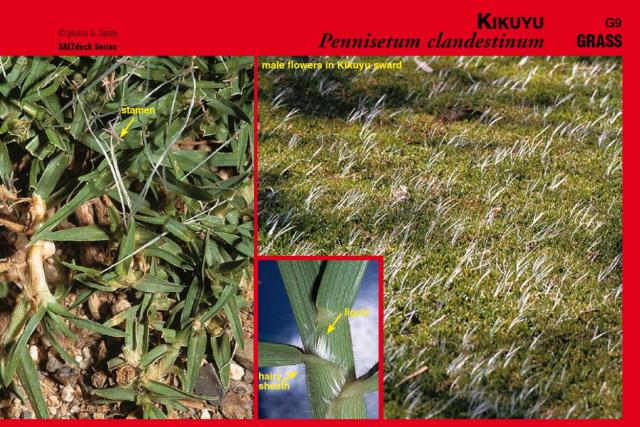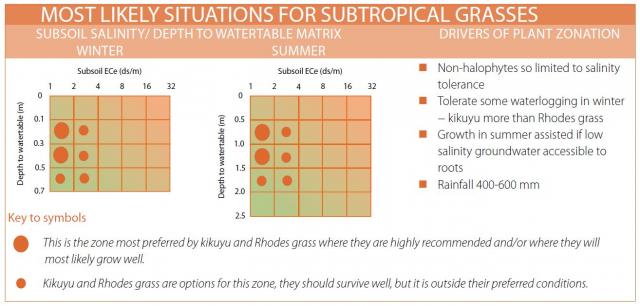Description
The taxonomy of kikuyu has been changed from Pennisetum clandestinum to Cenchrus clandestinus.
Kikuyu is a prostrate perennial grass, which may form a loose sward up to ~50cm high when ungrazed, but becomes a dense turf when grazed. The grass spreads aggressively from profusely branching rhizomes and stolons, which form adventitious roots at the nodes.
Short leafy branches are produced from the stolons. Leaves expand to 50–100mm long and 6mm wide (Figure 1). The leaf surface has sparse soft hairs.
The small flower on the variety know as Whittet consists of a cluster of 2–4 short (1.5–2.0mm) spikelets, partly enclosed in the uppermost leaf sheath. Each spikelet has up to 15 delicate bristles up to 1.5mm long and two florets. The older common variety does not produce viable seed and does not flower.
The varieties are common kikuyu (vegetative propagation), Whittet and Noonan (from seed or vegetatively).
Occurrence
Kikuyu originated as a forest margin species of the highland plateaus of east and central Africa in areas that received 1000–1600mm of average annual rainfall. It is named after the Kikuyu people of Kenya who traditionally lived east of the Aberdare Mountains in a region where the grass thrives. Seed was introduced to Australia from the Congo in 1919.
Benefits
Production
On non-saline land, productivity is highly dependent on soil fertility, especially nitrogen. Production on saltland is therefore likely to be increased by using nitrogen fertilisers. In some situations, there are salt tolerant legumes that can be grown in a kikuyu pasture, and supply nitrogen.
The nutritive value of Kikuyu on non-saline land declines from early summer to late autumn. Stands are likely to be of better value in autumn if they are hard-grazed and not allowed to become ‘woody’. If kept short and activity growing through its main growth period of spring through to late autumn, digestibility can exceed 70%.
Production is likely to be less on salt affected land, but the seasonal change and grazing management are likely to be the same as on non-saline land.
Suitable sites
Kikuyu is particularly suited to deep sand soils and waterlogged sites, and is not usually recognised as being adapted to saltland. However, in NSW, the cultivars Whittet and Noonan have grown successfully on scalds with ECe values in the range 1200–2000 mS/m (highly to severely saline). This suggests that kikuyu can be successful on seepages of low to moderate salinity. See measuring soil salinity for more information and values for other salinity measures.
Kikuyu has an excellent capacity to use moisture at depths of 0–60 centimetres in the soil profile, and can root down to seveeral metres. In the salinity/waterlogging matrix (Figure 2), we have ranked this species as low tolerance to salinity, moderate to high tolerance to waterlogging.
Common indicator species
Kikuyu is unlikely to grow where the ‘classic’ indicator species for saltland are growing (sea barleygrass, marine or saltwater couch, water buttons) – the levels of salinity and/or waterlogging will exceed the tolerance of kikuyu. The classic indicator species are likely to be towards the centre of a saline site where the salinity levels are typically highest, and the land suitable for kikuyu will tend to be towards the edges of the saline site and in the surrounding non-saline areas.
Kikuyu is likely to perform well where the indicator species barley grass, annual ryegrass or windmill grass (a native, warm season grass) are growing. These indicator species are quite widespread in mildly saline and non-saline environments, and should be considered as weak indicators unless they are specifically located around the margins of more saline land.
Salinity and waterlogging requirements
Irrigation water of 400–500mS/m can reduce kikuyu shoot dry weight by 50%. Note: salinity levels measured in the soil are not directly comparable with measuring the salinity of irrigation water. Kikuyu will grow well in soils with low salinity (200–400mS/m) and to a lesser extent in soils with moderate salinity (400–800mS/m).
Waterlogging damages the growth of kikuyu by reducing the oxygen supply to the roots. Plants like kikuyu that are highly tolerant of waterlogging usually have special roots (with aerenchyma) that can bring air from the soil surface. For the subtropical grasses, and others that are not highly salt-tolerant, any increase in waterlogging reduces the tolerance for salinity.
We recommend controlling surface water flows to reduce waterlogging and inundation. The toxicity of salt to plants is increased in waterlogged conditions. By diverting surface water away from the site, it is likely that kikuyu will be more productive, and a larger proportion of the saline area will be suitable for them. There are not usually any legal restrictions associated with diverting non-saline surface water away from a saline site in order to reduce inundation and waterlogging.
On the other hand, drainage of saline water is covered by legislation: you must give at least 90 days notice — to the Commissioner of Soil and Land Conservation — of an intent to drain subsurface water to control salinity and discharging that water onto other land, into other water or into a watercourse. The notice must be in writing using the notice of intent to drain or pump (NOID) form. Principles and guidelines for inland drainage are covered in the policy framework for inland drainage.
Soil requirements
Kikuyu is widely adapted across many soil types, similar to Rhodes grass, and is naturalised on many of the deep sandy and gravelly coastal soils. It is more waterlogging tolerant than Rhodes grass and performs well on medium and well-drained soils. Kikuyu is highly tolerant of acid soils.
Nutrient requirements
Download the bulletin Improving subtropical grass pastures on the south coast of Western Australia for information on nutrient management on non-saline pastures and adapt this to the saline site.
Climatic requirements
Kikuyu is a C4 species that require temperatures in excess of 15°C for their photosynthetic pathway to operate. For salinity management, this means kikuyu is suited suited to the agricultural regions of WA with >400mm annual rainfall, to the northern agricultural region in WA and to central and northern NSW.
Kikuyu is reasonably hardy and will respond well to summer/autumn rain. For saline sites where salinity levels often build up over summer, this summer rainfall is probably essential for leaching salt out of the topsoil and keeping the salinity levels within the range that can be tolerated by kikuyu. If the saline site has a relatively shallow watertable that is only mildly or moderately saline, kikuyu's deep roots will be able to access this groundwater.
Kikuyu will yellow and even die with severe frosts. However, it will usually recover after frosts from stolons and rhizomes. Away from the coast, low temperatures in winter will restrict growth. This can be an advantage to pasture production by allowing winter active legumes to increase.
Establishment
From seed or using stem or root cuttings (depending on cultivar), though establishment by seed is the most common method. Kikuyu generally requires a soil temperature of >18°C for germination.
We recommend:
- planting in spring
- a fine, even seed bed
- good weed control
- seeding to 10mm or less
- controlling red legged earth mite as seedlings emerge.
For more information
Sanford, P, Master, R & Dobbe, E 2018, Improving subtropical grass pastures on the south coast of Western Australia, Bulletin 4892, Department of Primary Industries and Regional Development, Western Australia, Perth.



